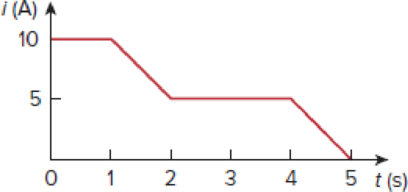
Concept explainers
The current through an element is shown in
- (a) t = 1 s
- (b) t = 3 s
- (c) t = 5 s
Figure 1.26
For Prob. 1.9.

Fig. 1.26. Determine the total charge that passed through the element at:
(a)
Find the total charge flows through the element at
Answer to Problem 9P
The total charge flows through the element at
Explanation of Solution
Given data:
Refer to Figure 1.26 in the textbook to solve the required objective.
Formula used:
Write the expression for charge entering to an element from
Here,
Calculation:
The given figure is a waveform of electric current versus time.
As the time
From the given figure, the current for the interval
Substitute 10 A for
Simplify the expression as follows:
Conclusion:
Thus, the total charge flows through the element at
(b)
Find the total charge flows through the element at
Answer to Problem 9P
The total charge flows through the element at
Explanation of Solution
Calculation:
As the time
Substitute 0 s for
Rewrite the expression as follows:
Calculate the expression for current from 1 s to 2 s as follows:
From the given figure, the current is 10 A during 0 to 1 s,
Simplify the expression as follows:
Conclusion:
Thus, the total charge flows through the element at
(c)
Find the total charge flows through the element at
Answer to Problem 9P
The total charge flows through the element at
Explanation of Solution
Calculation:
As the time
Substitute 0 s for
Rewrite the expression as follows:
From Part (b), the current for 1 s to 2 s is
Calculate the expression for current from 4 s to 5 s as follows:
From the given figure, the current is 10 A during 0 to 1 s,
Simplify the expression as follows:
Conclusion:
Thus, the total charge flows through the element at
Want to see more full solutions like this?
Chapter 1 Solutions
Connect 2 Semester Access Card for Fundamentals of Electric Circuits
- wire sample (1mm in diameter by 1m in length) is placed in an electrical circuit at 20°c. A voltage drop of 432 mV is measured across the length of the wire as it carries a 10 A current Calculate the electrical conductivityarrow_forward1. A group of 5 x 1016 free electrons passed a point in a conductor in 20 s. Find the current flowing. 2. A water heater has a resistance of 5.5 Ω and draws a rated current of 40 A. Find the kWh consumed in a period of one month if the heater is in service on the average of 1.5 hours per day.arrow_forward1. A No. 12 copper wire common to house wiring installations has a cross- sectional area of 0.00513 sq. in. Calculate the electron velocity when the current is 15 Amp.arrow_forward
- H.W.: A copper wire of commercial purity is needed to conduct 10 A of current with a maximum voltage drop of 0.4 V/m. What must be it minimum diameter? The electrical conductivity of pure copper is 5.85 × 107 (Ω m) -1 , compute the maximum diameter of the wire. (Take the wire length 1m)arrow_forwardThe voltage v = 10cos2t V across a device and the current through it is 20(1 − e-0.5t )mA. Find thea. the total charge in the device at 1sb. the power consumed by the device at 1s.arrow_forwardFind the charge q(t) flowing through a device if the current is i(t).arrow_forward
- A current of 2A flows in a wire offering a resistance of 10ohm. Calculate the energy dissipated by the wire in 0.5 hours.arrow_forward1. Why is electrical energy preferred over other forms of energy ?2. Write a short note on the generation of electrical energy.3. Discuss the different sources of energy available in nature.arrow_forwardA 12 V lead-acid car battery has a measured voltage of 11.2 V when delivers 40 A to a load. What are the load and the internal battery resistances? Determine its instantaneous power and the rate of sulfuric acid consumptionarrow_forward
- Know and be able to use the definitions of voltage and current The current at the terminals of the element isi=0,t<0;i=20e−5000t, A,t≥0;Calculate the total charge (in microcoulombs) entering the element at itsupper terminal.arrow_forwardFind the charge q(t) flowing through a device if the current is i(t) = 20 cos(10t + π/6) μA, q(0) = 2μC.arrow_forwardIf electrons travel from the negative to the positive terminal of an 8-volt battery. How much energy could be supplied? Express your answer in nano(n).arrow_forward
 Introductory Circuit Analysis (13th Edition)Electrical EngineeringISBN:9780133923605Author:Robert L. BoylestadPublisher:PEARSON
Introductory Circuit Analysis (13th Edition)Electrical EngineeringISBN:9780133923605Author:Robert L. BoylestadPublisher:PEARSON Delmar's Standard Textbook Of ElectricityElectrical EngineeringISBN:9781337900348Author:Stephen L. HermanPublisher:Cengage Learning
Delmar's Standard Textbook Of ElectricityElectrical EngineeringISBN:9781337900348Author:Stephen L. HermanPublisher:Cengage Learning Programmable Logic ControllersElectrical EngineeringISBN:9780073373843Author:Frank D. PetruzellaPublisher:McGraw-Hill Education
Programmable Logic ControllersElectrical EngineeringISBN:9780073373843Author:Frank D. PetruzellaPublisher:McGraw-Hill Education Fundamentals of Electric CircuitsElectrical EngineeringISBN:9780078028229Author:Charles K Alexander, Matthew SadikuPublisher:McGraw-Hill Education
Fundamentals of Electric CircuitsElectrical EngineeringISBN:9780078028229Author:Charles K Alexander, Matthew SadikuPublisher:McGraw-Hill Education Electric Circuits. (11th Edition)Electrical EngineeringISBN:9780134746968Author:James W. Nilsson, Susan RiedelPublisher:PEARSON
Electric Circuits. (11th Edition)Electrical EngineeringISBN:9780134746968Author:James W. Nilsson, Susan RiedelPublisher:PEARSON Engineering ElectromagneticsElectrical EngineeringISBN:9780078028151Author:Hayt, William H. (william Hart), Jr, BUCK, John A.Publisher:Mcgraw-hill Education,
Engineering ElectromagneticsElectrical EngineeringISBN:9780078028151Author:Hayt, William H. (william Hart), Jr, BUCK, John A.Publisher:Mcgraw-hill Education,





